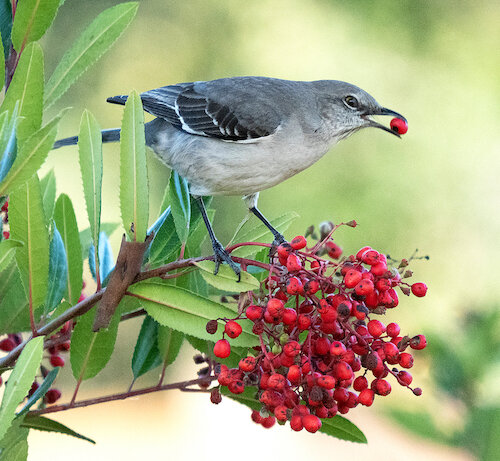Northern Mockingbird
by Dave Zittin
Do you like early morning serenades? If so, you will love the Northern Mockingbird, the avian Pavarotti of the neighborhood. An unmated male will sing throughout the night. Paired males start their serenading just before sunrise. Northern Mockingbirds are members of the family Mimidae, the mimics. Thrashers are also in this family.
Eating Toyon berries. Note two wing bars and a slightly decurved bill. Photo by DeAnne Tucker.
The Northern Mockingbird learns new songs throughout its life. The adult male sings about three quarters of the year, starting in February, finishing in August, then starts up again in late September, finishing in November. They learn songs from other members of their species, non-related species and non-biological sources, for example, car alarms and rusty gate hinges. A few months ago, I was thrilled to hear an Ash-throated Flycatcher in the neighborhood. I tracked it down, but found a Northern Mockingbird, doing a near perfect mimic of the flycatcher!
Northern Mockingbirds have a few unique calls that can be used for identification. One in particular is the alarm or “churr” call that is used when predators or competitors are nearby. I hear this call daily in our backyard, especially when our local, pugnacious mockingbird attacks a crow that shows up to eat bird seed.
Two wing bars, black eye line and slightly decurved bill. Gray to blackish upper parts and buff under parts. Photo by Gena Zolotar.
The Northern Mockingbird’s persistent singing made them sought after as cage birds from the late 1700s to the early 1900s. Captured adults were the best because of their naturally acquired song repertoire. Indeed, the Northern Mockingbird may have been one of the first White House pets. “Dick the Mockingbird”, as it was named, was adored by Thomas Jefferson.
Attracting Mockingbirds to Backyards
Grassy yards attract Northern Mockingbirds. Also, fruiting bushes are attractive. They normally avoid feeders, but this year (2021) was an exception for our backyard. A very territorial mockingbird decided that it likes grape jelly, which I use to attract Hooded Orioles. If an oriole lands on the jelly feeder it is immediately dive-bombed by the mockingbird, and we have not seen orioles for many weeks. It also eats from our suet feeder. These feeding activities are unusual, and I suspect are the result of a very dry year and perhaps a lack of preferred foods. Normally, Northern Mockingbirds are omnivorous, feeding on insects and worms during the spring and summer and then fruiting bodies later in the summer and autumn.
Description
The Northern Mockingbird has a narrow black eyeline, two white wing bars, gray upper parts and white lower parts. It flashes a conspicuous white wing patches in flight.
The outer tail feathers are white and the central tail feathers are dark-colored. The black bill is fairly long and slightly decurved. When confronting an intruder, the Northern Mockingbird will raise its wings part way or raise them high, showing off the white patches. This likely makes the bird look larger and more threatening. This wing flashing might also be used to flush prey from hiding places.
Note bold white wing spots and white outer tail feathers. Photo by Sonny Mencher.
Distribution
Northern Mockingbirds are a New World species in the genus Mimus and can be found in all the states, Southern Canada, most of the Caribbean Islands and throughout most of Mexico including the Baja California Peninsula. There are fourteen Mimus species, all of which are New World species, found mostly in Latin America.
Similar Species
In Santa Clara County, the Loggerhead Shrike probably looks most similar to the Northern Mockingbird, The mockingbird lacks the conspicuous black mask, the jet-black wings, the clean gray back and the heavy hooked bill of the Loggerhead Shrike. The California Thrasher sounds somewhat like a mockingbird. Be careful using sound to make an identification. When singing, the mockingbird tends to repeat phrases several times. The thrasher rarely repeats a song phrase more than 2 times before moving onto the next phrase.
Explore
General Information on the Northern Mockingbird
Listen to Songs #1 and #3 for phrases that are repeated 3 or more times. The “churr” alarm call of the Northern Mocking bird can also be heard here.
More on “Dick the Mockingbird”
More Backyard Bird Information
View more common Santa Clara County Backyard Birds
Visit our Backyard Birding page
Read our Notes and Tips from a Backyard Birder series
Tell us what you’re seeing in your yard! Send your notes, photos, and sound clips to backyardbirds@scvas.org. We’ll feature your submittals on our website.
Banner Photo: Northern Mockingbirds by Aaron Wippold




